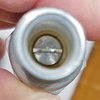Not sure if we can determine a smoking gun here or not, but it’s worth a shot.
Recently I’ve been experiencing what seems like a misfire or skip during flight. The run-up seems normal and everything is fine during high power (takeoff and climb), but after leveling off and reducing power to cruise, a misfire or skip-like episode occurs intermittently. I can tell that there seems to be slightly more vibration in the controls (pedals and yoke) than usual as well, like the engine just isn’t quite running as smoothly as it should be. To add, sometimes the skip will also be noticeable when reducing power to descend. I wish I could describe it better, but that’s the best description I can provide.
Today, the IA checked all eight spark plugs under pressure and found one that was bad and replaced with new, cleaned the remaining seven and rotated them from top to bottom. The problem still persists, so the plugs can be ruled out. The mags are the next item on the list to be examined. They’re 23yr old slicks and have 430hrs on them, so it’s about time (is time in my book) for the 500hr service. I did an in-flight mag check and the skip/misfire occurs noticeably, so I’m quite certain it’s an ignition issue.
If the mags come back and the problem still persists, what might the next thing be? Could a sticking valve cause what I’ve described? And has anyone else experienced something like this?
Recently I’ve been experiencing what seems like a misfire or skip during flight. The run-up seems normal and everything is fine during high power (takeoff and climb), but after leveling off and reducing power to cruise, a misfire or skip-like episode occurs intermittently. I can tell that there seems to be slightly more vibration in the controls (pedals and yoke) than usual as well, like the engine just isn’t quite running as smoothly as it should be. To add, sometimes the skip will also be noticeable when reducing power to descend. I wish I could describe it better, but that’s the best description I can provide.
Today, the IA checked all eight spark plugs under pressure and found one that was bad and replaced with new, cleaned the remaining seven and rotated them from top to bottom. The problem still persists, so the plugs can be ruled out. The mags are the next item on the list to be examined. They’re 23yr old slicks and have 430hrs on them, so it’s about time (is time in my book) for the 500hr service. I did an in-flight mag check and the skip/misfire occurs noticeably, so I’m quite certain it’s an ignition issue.
If the mags come back and the problem still persists, what might the next thing be? Could a sticking valve cause what I’ve described? And has anyone else experienced something like this?



